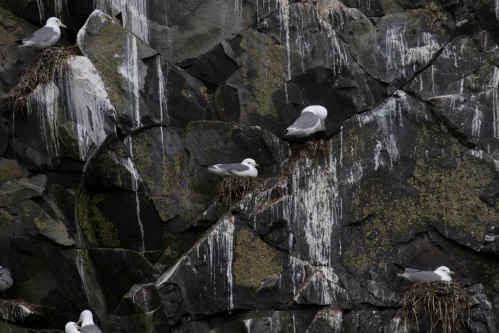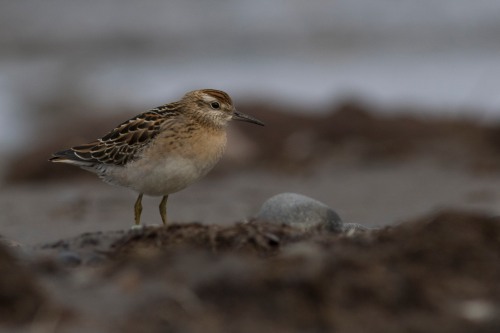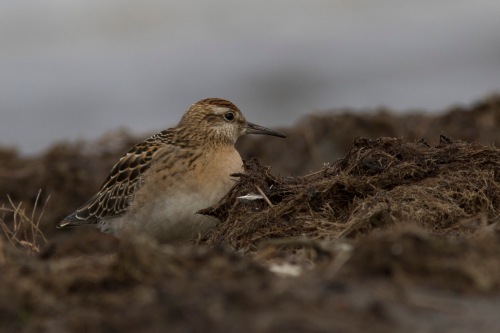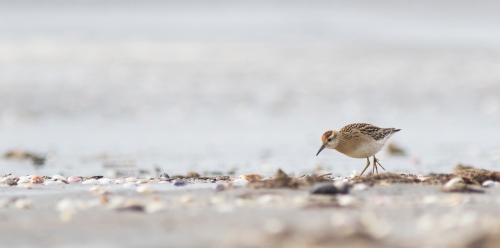Published in Marine Ornithology: Potential Northward Expansion of the Breeding Range of Red-legged Kittiwake Rissa brevirostris
by Bryce W. Robinson

Black-legged Kittiwake (Rissa tridactyla; left) and Red-legged Kittiwake (Rissa brevirostris; right).
In a new paper published in Marine Ornithology, we report on an important result from the 2018 expedition to St. Matthew Island – documentation of previously unrecorded breeding activities for a Beringean endemic, the Red-legged Kittiwake (Rissa brevirostris). Our trip to St. Matthew was focused on Mckay’s Bunting (Plectrophenax hyperboreus) and Pribilof Rock Sandpiper (Calidris ptilocnemis ptilocnemis), where we both censused the populations of each and conducted a fine scale nesting study. While conducting this work, we opportunistically catalogued species presence and abundance, which led to the discovery of a large number of Red-legged Kittiwake occupying large cliffs on the northwest side of the island.

Red-legged Kittiwake sitting on a nest (center) amidst Black-legged Kittiwake. This is one of ~50 individuals present at location B mentioned in the article.
Our paper in Marine Ornithology details what we found and where we found it, and also discusses the status of the species in the region. We discuss behaviors that we observed that indicated the birds likely attempted to breed on the island in 2018, although we were unable to confirm eggs or nestlings before we left in early July. Regardless, our observations of a few hundred Red-legged Kittiwake on St. Matthew is at least notable because it differs from past records that list only a handful of records of single individuals seen in waters near the island. Both the numbers and behaviors we observed indicate that the species has shifted its breeding range northward to include St. Matthew Island. Such a large latitudinal shift (~400 km) at a time of substantial change in the Bering Sea raises many questions, especially considering the status of populations at the core of the species breeding distribution, the Pribilof Islands.

Figure 1. from the published report in Marine Ornithology 47(2). I was able to include a Red-legged Kitiwake illustration to elegantly communicate the distribution and relative size of Red-legged Kittiwake colonies, including the newly discovered colony on St. Matthew Island.

Figures 2 and 3 from the report in Marine Ornithology 47(2). These figures describe the locations where birds were found, and their assortment on the cliffs relative to Black-legged Kittiwake.
As distributions of important food resources for seabirds shift, caused by aberrations in factors such as sea temperature, we expect to see distributions of seabirds that depend on these resources to shift as well (in the best case scenario). Currently, there seems to be ongoing massive starvation and die-off events of many seabirds in this region that are likely the result of an inability to respond to these changes in prey distributions. A northward shift in breeding distribution is promising for a Beringean Endemic, because it shows some plasticity in response to changes in resources. However, we understand aspects of the Red-legged Kittiwake diet that partly explain why it holds a restricted range. Although a relatively small number of these birds have moved north to breed, characteristics of the habitat at and around St. Matthew Island may limit their success to produce enough offspring to maintain population stability. The story is ongoing.
This shift in Red-legged Kittiwake distribution presents an opportunity to study species responses to climate change as they are occurring. Such study will not only further enlighten us on Red-legged Kittiwake life history strategies, but also on how species may or may not adapt to rapid fluctuations in food resources and climate caused by global anthropogenic activities. We need to stay focused on this region and these species, because they are telling us an important story.
*Because of our observations in 2018, in summer 2019 (late July-August) USFWS returned to St. Matthew Island to conduct a comprehensive seabird survey of cliff nesting habitat and check for nesting Red-legged Kittiwake. They observed similar numbers at the same locations as our observations in 2018, and confirmed both eggs and nestlings. These observations confirm that the Red-legged Kittiwake now breeds on St. Matthew Island (at least in some years), and extends the breeding distribution for the species northward by nearly 400 km.
eBird checklists that document the 2018 Red-legged Kittiwake observations:
https://ebird.org/view/checklist/S47170141
https://ebird.org/view/checklist/S47199741
https://ebird.org/view/checklist/S47170187
https://ebird.org/view/checklist/S47170740










